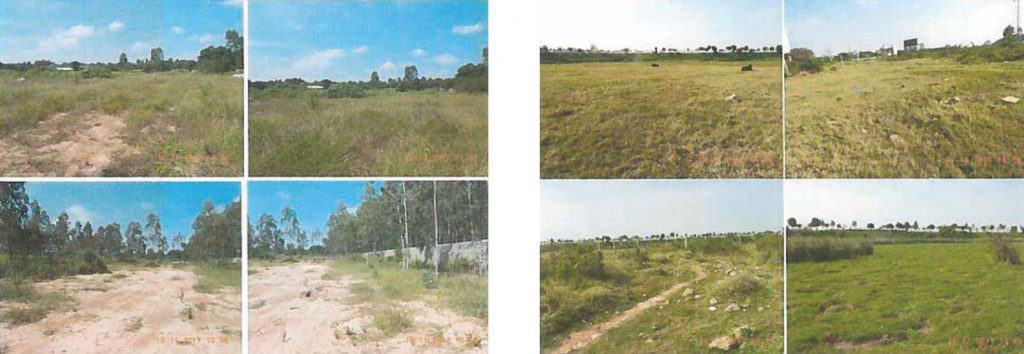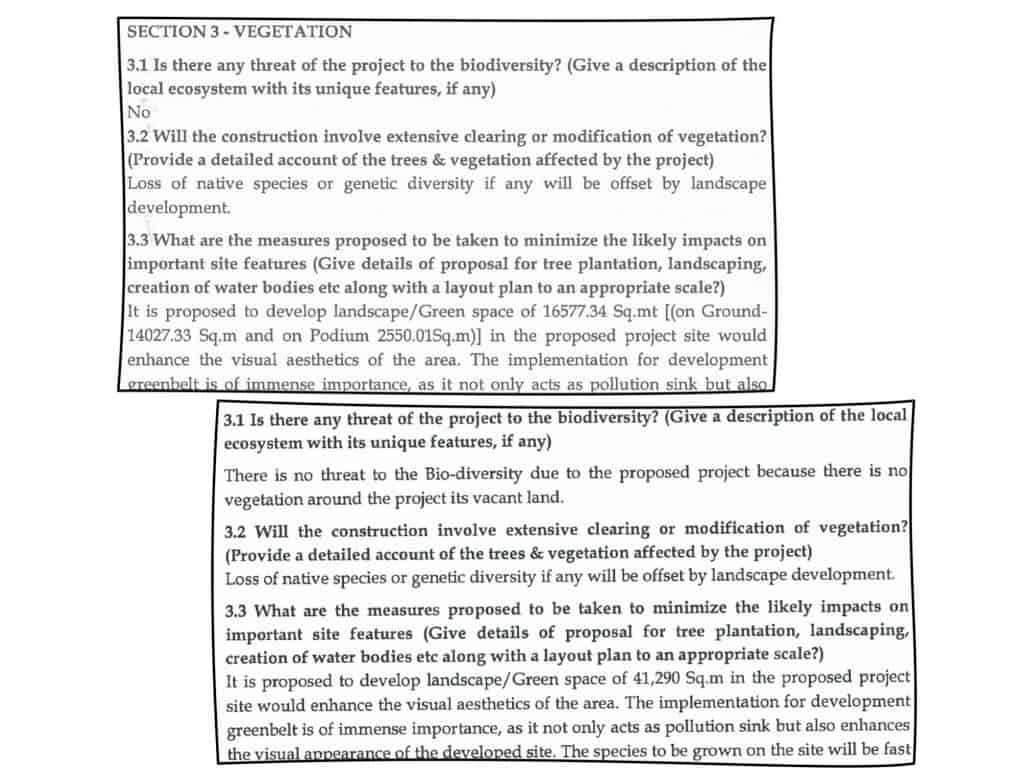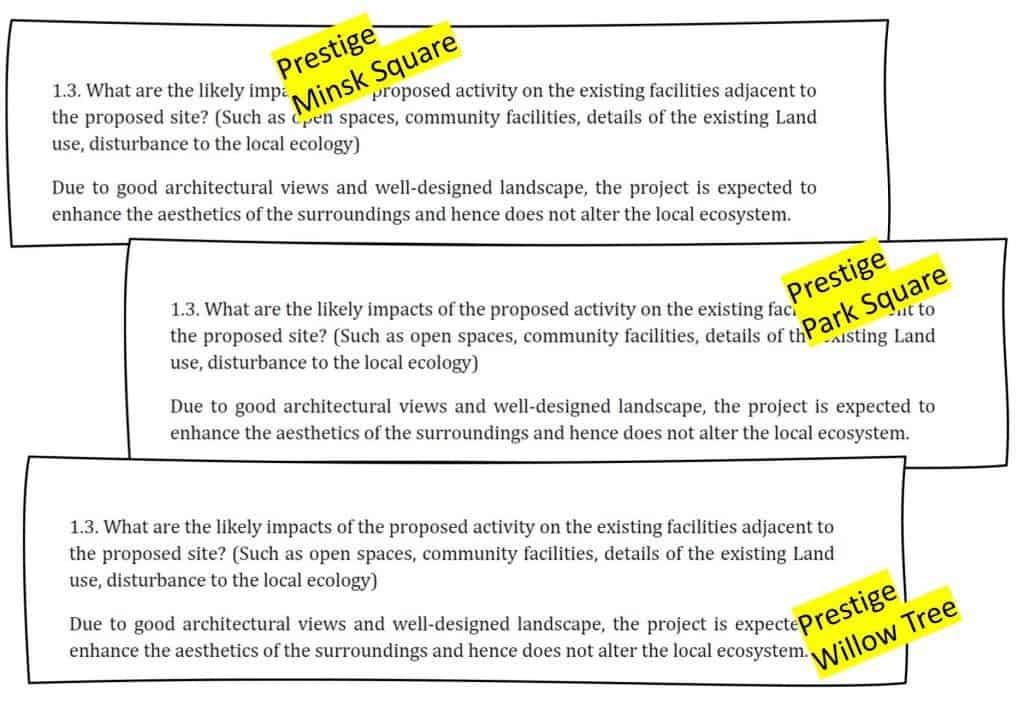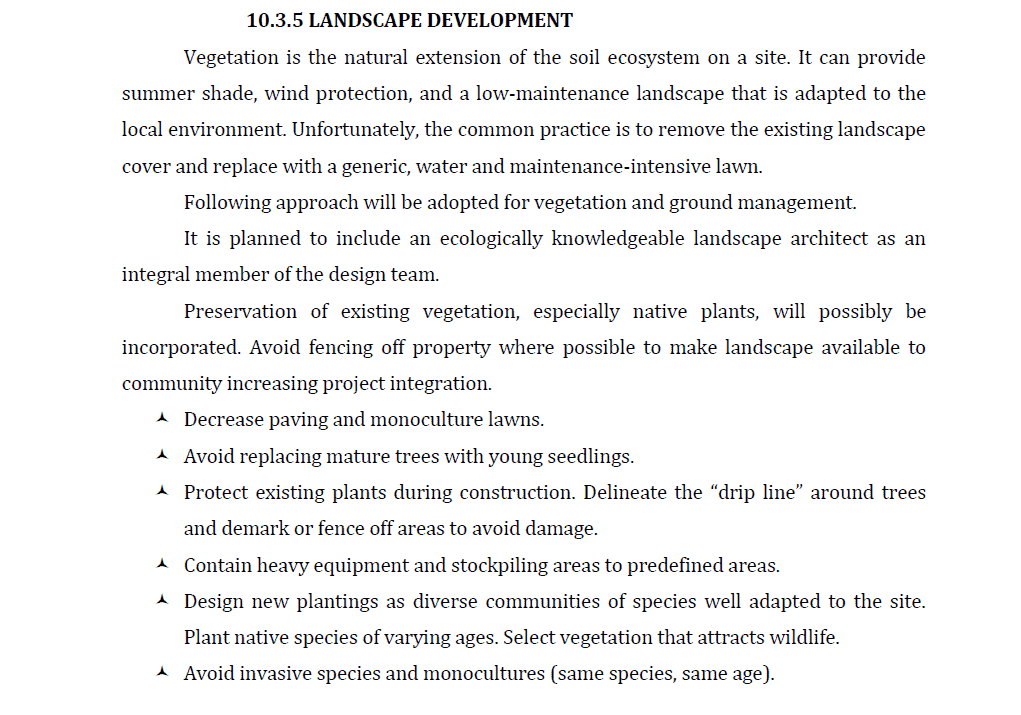Environment Impact Assessment (EIA) and Environment Management Plan (EMP). These are mandated by law to get environment clearance for large real estate development projects. Builders in Bengaluru, however, seem to have hit on an easy way to answer the detailed list of questions that the requisite forms ask for. Just copy-paste answers from one project to another, irrespective of site location and local biodiversity requirements. As the consultants who prepare these EIAs and EMPs are often common to more than one project, it is easily done.
This three-part series examines how the builders responded to the questions on biodiversity and environment in their project sites, and how the state authority that gives environment clearance scrutinised these. In the projects this writer looked into which had got environment clearance, when it came to protecting the site’s biodiversity, the wording on the relevant forms were more often similar. In many cases identical, even when the project locations were diverse in every respect. “Landscaping” seemed the most favoured solution to all aspects of biodiversity.
To specific questions from the writer based on the information given by them on biodiversity and environment management, neither builders nor consultants gave an adequate response. Or did not respond at all. The state authorities said they would look into this issue.
In every project examined in this series, this writer tried to talk to all the parties concerned to clarify matters. The answers, if they came at all, were always general and vague. And all laced with the attitude: “Biodiversity? What biodiversity”?
Read on and learn much more about how builders keep winning the battle against the laws and rules meant to protect the environment
As the fourth most populous metropolitan city in India, Bengaluru is a favoured market for real estate developers. However, studies point out that built-up areas have been replacing the city’s green cover and wildlife habitats.
At least 41 species of mammals including jungle cats, common mongoose, several species of bats and rodents, and even the occasional leopard have been sighted in Bengaluru and its fringes. The city is also home to over 300 species of birds, including migratory birds from Central Asia and the Arctic, 17 species of amphibians, 52 species of reptiles and 1707 species of insects and arachnids (such as spiders).

Real estate projects in India were brought under the purview of the Environment Impact Assessment (EIA) Notification in 2004 to address their environmental impact. But civil society organisations have documented the mass clearances given to construction projects in Bengaluru.
“State governments have a “laissez faire approach towards real-estate companies,” says Leo Saldanha, Convenor of the NGO Environment Support Group.
TheState Environment Impact Assessment Authority (SEIAA) is the agency responsible for giving Environment Clearance (EC) to projects in Bengaluru. Without EC, builders are not allowed to even prepare the site for construction. This reporter examined the EIAs of several real estate projects approved by the SEIAA.
How EC application process works
- Projects with less than 20,000 square metre of built-up area don’t require EC, as they are assumed to have a minimal impact on the environment.
- For projects with built-up area between 20,000 and 1,50,000 sq m, builders have to apply for EC by submitting two forms (Form 1 and Form 1a), and a conceptual plan of the project.
- Larger projects, with built-up area over 1.5 lakh sq m or sital area more than 50 ha, have to submit a detailed Environmental Impact Assessment (EIA) to get EC.
This article looks at the second category – projects with built-up area between 20,000 and 1,50,000 sq m.
For these projects, Form 1 gives the SEIAA basic information including the sital and built-up area, water and energy consumption, and the presence of Protected Areas such as forests and lakes on the site. Whereas Form 1a is a detailed checklist of the anticipated environmental impact from construction and operation of new buildings.
Form 1a also includes an Environmental Management Plan (EMP) from the builder to mitigate the environmental impact.
For a majority of building projects, these documents are the only source of information for SEIAA to make a decision.
Once the company submits these documents, SEIAA examines them and passes them over to the State Environmental Appraisal Committee (SEAC) – a body comprising experts in fields like pollution, hydrology and ecology. After examining the applications, the SEAC may ask the applicants for additional details, or recommend clearance. Based on the SEAC’s recommendation, SEIAA issues EC for the project.
Read more: Unchecked tree loss is wiping out the Slender Loris from Bengaluru
Few details submitted, yet real estate projects get clearance**
Based on a random selection of projects from the SEIAA website, it seems project proponents are free to decide how detailed their submissions should be.
For instance, in 2018, SEIAA cleared a proposal by Vaishnavi Anushka Infrastructure LLP, for a residential apartment with a built-up area of 1.08 lakh sq m, spread over a 43,806.8 sq-m plot in Ananthapura Village, Yelahanka. In Form 1, the builder acknowledged that vegetation would be cleared for site levelling. But, under the ‘Vegetation’ section in Form 1a, to the question on any threat to biodiversity, the builders merely responded, “No”.
Further, in Form 1a, on whether construction would involve modification or clearing of existing vegetation, the builder stated: “Loss of native species or genetic diversity if any will be offset by landscape development”. No details of trees, shrubs or herbs that would be cleared from the site were given even though the form asks for such details.

In the same form, to the question about displacement of fauna from the project site, the builder responded, “Not applicable”. On any direct or indirect threat to avifauna, the builder responded: “The project will not have any direct or indirect impacts on avifauna.”
No further details were provided, and none were asked for by the SEIAA as per the EC report uploaded on the website of MoEFCC (Centre’s Ministry of Environment, Forest and Climate Change).
I found similar responses in the forms submitted for another residential project, cleared around the same. This project by M/s Akruthi Enterprises and Adarsh Enterprises was to have a built-up area of 1.45 lakh sq m, on a plot area of 90,303 sq m.
The 2017 Google Earth images of the project site, submitted by the builder, shows the presence of greenery; and the site photographs show an open-grassland type habitat. In Form 1, the builders stated that the project site was vacant land covered with vegetation. To the question of whether vegetation would be cleared, the builders responded “No”, but added, “The project requires clearing of some plant species and trees. Levelling of site prior to construction is required. Landscape development will be carried out.”
Under the ‘Vegetation’ section of Form 1a, to the question on threat to biodiversity, the builders responded: “There is no threat to biodiversity because of the project because there is no vegetation around the project its vacant land [sic],” contradicting their own statement in Form 1 that some plants and trees would be cleared. Other responses in Form 1a about modifying or clearing existing vegetation, details of landscape development and impact to fauna are identical to that submitted by Vaishnavi Anushka Infrastructure LLP.
The EC process for both these projects were handled by the same consultant, Environmental Health and Safety (EHS) Consultants Pvt Ltd. I emailed questions on the process to Vaishnavi Anushka Infrastructure LLP and EHS Consultants. The former didn’t respond; the latter, over a phone conversation on July 19th, acknowledged receiving my email, but did not respond to the questions.
I was unable to find any direct contact information for Akruthi Enterprises and Adarsh Enterprises.

Biodiversity details were the same for projects in core city areas and outskirts
Another example of near-identical responses appears in the case of three projects of Prestige Constructions – two residential and one commercial – cleared between 2016 and 2018. Prestige Park Square in Begur, South Bengaluru, and Prestige Willow Tree in Yelahanka, North Bengaluru are apartment complexes; Prestige Minsk Square along Cubbon Road is a commercial space.
While details on water and energy consumption and waste generation vary in the forms, the responses on biodiversity are nearly identical.
In Form 1a, in response to the query, “What are the likely impacts of the proposed activity on the existing facilities adjacent to the proposed site? (Such as open spaces, community facilities, details of the existing land use, disturbance to the local ecology),” all projects have responded thus: “Due to good architectural views and well-designed landscape, the project is expected to enhance the aesthetics of the surroundings and hence does not alter the local ecosystem.”
On whether the projects would impact fauna, all four projects simply answered, “No”. The builder’s response did not take into account the project’s specific locality, even though Prestige Minsk Square was being proposed in a commercial area in the heart of Bengaluru while Prestige Park Square was to be located just six kilometres from the Bannerghatta National Park.

I sent the SEIAA a detailed questionnaire asking how the details provided by builders mentioned above, were verified. Over a phone conversation on July 27, SEIAA Chairman K R Sreeharsha told me that builders usually give presentations to the SEAC when it meets to evaluate applications; and in case of any issues, SEAC would raise them during the meeting. He declined, however, to comment on the specific projects over the phone adding that the SEIAA would look into my questions and respond.
EMPs hardly touch up on biodiversity
I also found that the Environmental Management Plans (EMPs) of different projects appear to have near-identical responses about biodiversity. EMPs have to outline a comprehensive plan for environmental monitoring during and after construction, and include details on wastewater recycling, disposal of construction debris, etc.
But most EMPs I examined had very little detail on biodiversity management. Several only focused on issues like pollution and waste disposal, with a brief mention of creating a green belt area around the project site. But the details on green belt area were not customised to the project locations, and no attempt was made to identify what sort of biodiversity would be encouraged there.
For instance, the EMPs of Akruthi Enterprises and Adarsh Enterprises, and Vaishnavi Anushka Infrastructure, were nearly identical except for a few project-specific details like sital area. Section 10.9 of their EMPs (Greenbelt Development Plan), the only section pertaining to biodiversity, was also identical except for the greenbelt area mentioned.

The EMPs of the three Prestige projects mentioned previously were also nearly identical to each other as well as the EMPs of three other residential projects in North Bengaluru – one called ‘After the Rain’ by Total Environment Constructions cleared in 2019, others by Hoysala Builders and Biodiversity Conservation (India) Ltd cleared in 2016. I also found an affordable housing project in Ramanagara taluk by Neelanchal Dwellings (a subsidiary of Salarpuria Sattva group) granted EC in 2017, with the same EMP.
In these seven EMPs, biodiversity was touched upon in only one section titled ‘Landscape Development’ carrying identical and generic text. The builders provided no details of assessing the existing biodiversity and developing a specific plan to restore biodiversity based on the project location.

What real estate builders and consultants say
Mahesh D J, Senior AGM, Environment, at Prestige Estate Projects, told me over a phone call on July 19th that the EMPs had been handled by an external consultant, A and N Technologies. He added that the builders collected data from site visits and discussions with architects, landscape consultants and engineers which was passed on to the consultant who then created the reports.
When asked about the identical text in the EMPs for the three Prestige projects, Mahesh said that a lot of information might be common across projects and might be “copy-pasted”. He didn’t respond on why some sections in their EMPs were identical to that of other builders’ projects.
Pushpalatha Vijayakumar, Environmental Engineer at A and N technologies, confirmed to me over a phone call on July 20, that they had worked on the EMP for the three Prestige projects and also that of Neelanchal Dwellings.
Read more: Elevated corridors: Environment Clearance was issued in just two weeks
Over a phone call on July 20, I asked Sanjay Kumar, the founder of A and N Technologies, about the identical EMPs for projects of varying sizes and locations. He said EMPs were primarily meant to address three impacts of construction projects – air and soil pollution, water consumption, and wastewater disposal and sewage treatment. He added that the Prestige project sites were chosen according to the BDA’s Revised Master Plan 2015, which designates land for residential or commercial use. And that the BDA would not designate sites which had endangered or rare species, for such uses.
Specific to the Prestige projects, he said they would have very little impact on biodiversity as they were built on barren land. While this appears to be true for Prestige Minsk Square located along Cubbon Road, Form 1 of Prestige Park Square on Bannerghatta Road mentions the presence of “few coconut trees, mango trees, Silver trees, Tamarind trees and Honge trees” which would be cleared. Also, Form 1 of Prestige Willow Tree mentions the presence of shrubs that would be cleared.
Sanjay said the trees planted during landscaping for these projects would attract more biodiversity. Both Sanjay and Mahesh said that customised ‘Landscape Development Plans’ had been prepared for each project, but I could not find these on the SEIAA website. Sanjay did not respond when asked whether open lands with shrubs and herbs could also be considered biodiversity.
According to Form 1 of Prestige Park Square on Bannerghatta Road, the site was agricultural land, converted to residential use by the 2015 Master Plan. Sanjay did not respond to my question on whether birds like Pied Bushchats and Black Drongos which prefer open spaces and are common in agricultural land, should have been considered in this EMP. He also did not respond on whether insect diversity, which also depends on the type of vegetation, had been considered.
He said he couldn’t recall the Neelanchal Dwellings project and would look into it.
Though Sanjay and Mahesh had agreed to respond to my email questionnaire, I have not received their responses yet.
SEIAA Chairman Sreeharsha told me over the phone on July 27, that EMPs should be customised for each project, and that the SEAC would look into whether there was “region-wise uniformity in the biodiversity aspect” while examining them. When asked why projects in different parts of Bengaluru and even Ramanagara were cleared on the basis of identical EMPs, he said the SEIAA would look into it. The projects mentioned in this article had been cleared during the tenure of the previous SEIAA committee.
EMPs of the four Prestige Projects, Neelanchal Dwellings, Hoysala Builders and BCIL have since been removed from the SEIAA website. We have copies of the documents downloaded from the SEIAA website. The EIA Notification, 2006, states that all project-related documents must be publicly available on the SEIAA portal – a fact Sreeharsha confirmed to me. He said the documents were temporarily unavailable since the SEIAA website was facing software glitches.
In Part 2 of this series, we shall look at larger ‘township’ projects with built-up area over 1.5 lakh sq m. On paper, the criteria for EC is much stricter for these projects, but are these followed in practice?
This article is part of a series on ‘Bengaluru’s Ecosystems and Biodiversity’. This is a joint project with Mongabay India, and is supported by the Bengaluru Sustainability Forum.
Also read:
- PRR: Massive environmental damage for another futile Ring Road?
- Bengaluru’s yes to Hesaraghatta film-city means a no to the Lesser Florican
** Corrigendum: The second sub-heading has been changed from the one in the first published version, which read: ‘Few details submitted, no EMPs, yet real estate projects get clearance’.